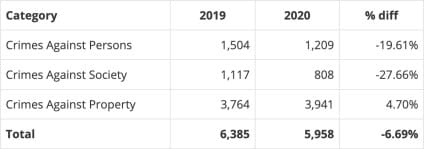Bloomington annual safety report: Crime down overall, pandemic impact felt, fire and police chiefs to dig into data on response times, race disparities

On Tuesday morning, Bloomington’s police and fire chiefs, along with the director of community and family resources department, delivered the city’s state of public safety report.

The presentation of such a report has been made an annual event by Bloomington’s mayor, John Hamilton. It is slotted ahead of the mayor’s state of the city address, which is scheduled this year for Thursday, Feb. 25.
Bloomington’s year in public safety for 2020 showed the effect of the COVID-19 pandemic.
Bloomington police made just 3,813 traffic stops in 2020 compared to 9,112 in 2019. The total calls for service to police dropped 15 percent from 54,065 in 2019 to 45,947 in 2020.
Fire department efforts toward fire safety community education suffered due to the pandemic.. Community education contacts, like station tours, dropped in 2020 to a third of their 2019 levels, from 10,634 to 3,436.
Hamilton previewed the three presentations by framing them with some of his top issues: gun crimes, fire rescues, and efforts to divert people away from the criminal justice system.
From police chief Mike Diekhoff’s report, Hamilton highlighted the increase in gun crimes, in the context of an overall downward trend in crimes against persons. That’s a category of crime in the National Incident-Based Reporting System (NIBRS), which the city now uses instead of the Uniform Crime Reporting (UCR) system.
Crimes against persons in Bloomington were down to 1,209 in 2020 compared to 1,504 in 2019, which made for a nearly 20-percent drop.
But crimes where a gun was used increased by 52 percent, according to Diekhoff’s report.
Among those were homicides, which increased from 2 in 2019 to 5 in 2020. In 2020, 4 out of the 5 homicides involved the use of a gun, according to Diekhoff.
From fire chief Jason Moore’s presentation, Hamilton highlighted the lack of any fatalities in fires, two saves of a life by firefighters and a high national rating for the department.
From Beverly Calender-Anderson’s community and family report, Hamilton highlighted the new Stride Center, a crisis diversion facility which opened in fall of 2020 on the lower level of Monroe County’s parking garage. So far, it has seen more than 295 referrals.
Moore and Diekhoff told The Square Beacon after their presentations that they would be digging into their departmental data to try to answer some additional questions.
For Moore it’s a question about response times.
For Diekhoff, it’s a question about disparities between the percentage of the department’s arrestees who are Black and the percentage of Bloomington’s Black population.
Fire department response times
The fire department’s goal is to respond to 90 percent of calls within four minutes and 98 percent of calls within 8 minutes.

The calculation for this year’s data on the four-minute goal was presented as 81 percent, or 9 points short of the goal.
The histogram presented with the response time data shows the bar labeled “4:00 to 4:59” minutes colored green. That means those calls are presented as hitting the target of within four minutes, even though the label for those calls indicates they took longer than four minutes.
Based on the height of the bars against the y-axis, the percentage of calls that hit the target of within four minutes looks like it’s closer to 64 percent, not 81 percent.
Asked about the discrepancy during the Q&A time, Moore said he thinks it could be an issue with the visualization provided by the automated report. After the presentation, Moore clarified to The Square Beacon that he thinks the rightmost bar does reflect times under four minutes down to three minutes—it’s not labeled correctly. He thinks that the first two bars should be collapsed into a single category.
In any case, Moore said he wants to dig into the raw data to understand what the bars represent. At least the labels on the bars will need to be corrected, Moore said.
In any case, Moore does not think the response times are such that the target is being hit just 64 percent of the time. “I will tell you just from experience, if we were only getting to our calls 64 percent of the time, we would not have the positive outcomes that we are seeing.” He added, “So I will definitely dig into it.”
Disparity in arrest numbers
Bloomington’s police department has recognized a disparity between the percentage of arrestees who are Black, which is around 20 percent, and the percentage of Bloomington’s Black population, which is around 4 percent.
About that disparity, one kind of response from the department has been to attribute the additional arrests to visitors from out of town.
At least on a cursory look, a BPD analysis seems to show that some of that disparity could be accounted for by out-of-town arrestees. For an August 2020 meeting of the city council’s public safety committee, BPD provided a Q&A document describing the analysis:
Our Data Analyst recently studied the demographics of those arrested by members of BPD and found that the percentage of Black individuals arrested in 2019 (384) equaled 19.28% of our total arrests made. However, of the Black individuals arrested in 2019, 156 of the individuals, or 40.6%, listed their home address as being outside the City of Bloomington.
But the Q&A report of the BPD analysis did not include a demographic profile of non-Black arrestees. If 40 percent of non-Black arrestees are also not from Bloomington, then none of the disparity in arrest numbers would be explained.
That’s why a public commenter at the August 2020 city council public safety committee meeting asked for an analysis of the demographics for non-Black arrestees.
After Tuesday’s state of public safety presentation, Bloomington police chief Mike Diekhoff told The Square Beacon he would look into getting the demographic profile for non-Black arrestees.




Comments ()